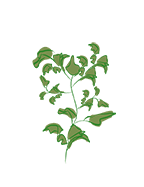
The wild species originated in the Andes Mountains of South America, probably mainly in Peru and Ecuador, and is thought to have been domesticated in pre-Columbian Mexico; its name is derived from the Náhuatl (Aztec) word “tomatl”. The tomato, along with corn, potatoes, chilli peppers and sweet potatoes was introduced to Europe in the early sixteenth century with the voyages of Columbus. In France and northern Europe, the tomato was initially grown as an ornamental plant and was regarded with suspicion as a food because botanists recognized it as a relative of the poisonous belladonna and deadly nightshade. Indeed, the roots and leaves of the tomato plant are poisonous and contain the neurotoxin solanine. Tomatoes were introduced to North America from Europe. The tomato was used for food in Louisiana as early as 1812, but not in the northeastern states until about 1835. It did not attain widespread popularity in the United States until the early 20th century. The plant is now grown commercially throughout the world.
The cultivated tomato, (Solanum lycopersicum), is the world’s most highly consumed vegetable due to its status as a basic ingredient in a large variety of raw, cooked, or processed foods. It belongs to the family Solanaceae, which includes several other commercially important species like potato, pepper, eggplant. This crop plant can be perennial or semi-perennial, but commercially it is considered an annual.
The growth habit of the plant varies from indeterminate to determinate. The primary root may grow several meters in length. The stem is angular and covered by hairy and glandular trichomes that confer a characteristic smell. Leaves are alternately arranged on the stem and range in shape from lobed to compound. All leaves are covered by glandular, hairy trichomes.
The tomato fruit is globular or ovoid. Botanically, the fruit is a berry, a simple fleshy fruit that encloses seeds in the pulp.
Tomatoes undergo four main stages of growth during their life:
Tomato is a perennial herbaceous plant, but it is often grown as an annual crop even if biennial and perennial forms exist. Tomato is cultivated in tropical and temperate climates in open field or under greenhouse in temperate climate. Greenhouses are often used for large-scale production. In warm climate with the right light intensity for growth, around 45 days are necessary from germination to anthesis and 90-100 days to reach beginning of fruit ripeness. The end use of the crop, whether for the processing market or fresh market, will determine the cultivars sown, the time of harvest and harvest processes, which can be manual or mechanical. Tomato is a rapidly growing crop with a growing period of 90 to 150 days. It is a daylength neutral plant. Optimum mean daily temperature for growth is 18 (64.4 °F) to 25°C (77 °F) with night temperatures between 10 (50 °F) and 20°C (68 °F). Larger differences between day and night temperatures, however, adversely affect yield. The crop is very sensitive to frost. Temperatures above 25°C (77 °F), when accompanied by high humidity and strong wind, result in reduced yield. Night temperatures above 2O°C (68 °F) accompanied by high humidity and low sunshine lead to excessive vegetative growth and poor fruit production. Tomato can be grown on a wide range of soils but a well-drained, prefer deep, well-drained sandy loams.
Tomato cultivation requests adequate fertilization: it is very important to avoid excesses or deficiencies of nutrients. This crop requires high amounts of potassium and calcium. The organic fertilization is very useful because bringing nitrogen, phosphorus, potassium, Magnesium, Calcium, trace elements, organic matter, it favors the good development and the health of the plants. It also helps to improve poor and tired soils and to avoid excess of salinity in the soil, which is the main problem with chemical fertilizers. Tomato absorbs large quantity of Potassium which influences the final quality of fruits. The Phosphorous favors roots growth in the early stages, and vegetative plant growth in addition to play an important role in fruit development. It is requested at the very first stage of the tomato development and more specifically in an organic form to avoid any insolubility issues. Nitrogen is required to obtain both good quantitative and qualitative results. It is recommended to bring nitrogen under organic form before transplanting and a further application at later stage. Calcium is useful to improve the firmness and the shelf life of tomatoes and to prevent apical rot. Boron applications ensure good fruit set, higher number of fruits and better fruit weight. Boron also has a positive effect on fruit quality and shelf life.
The crop also benefits from the application of products with a biostimulant action, based on beneficial microorganisms and vegetable protein hydrolysates. These products are able root development in the early stages, to improve the availability of nutrients in the soil, to increase the yield from a quantitative and qualitative standpoint and to reduce the negative impact of climatic stresses. The application of biostimulants increases the environmental and economic sustainability of the production system.

Before ploughing


Transplantation






Vegetative growth




Flowering




Fruit development




Agricultural soil is a fundamental component of the agricultural ecosystem. The most widely recognized function of soil is its support for food production. It is the foundation for agriculture and the medium in which nearly all food-producing plants grow. Healthy soils supply the essential nutrients, water, oxygen and root support that our food-producing plants need to grow and flourish. Soils also serve as a buffer to protect delicate plant roots from drastic fluctuations in temperature. Furthermore, the soil also performs hidden and less evident functions called ecosystem services. Careful soil management is one essential element of sustainable agriculture and provides a valuable lever for climate regulation and a pathway for safeguarding ecosystem services and biodiversity. Hello Nature propose an integrated approach to keep agricultural soil alive and healthy applying sustainable solutions: organic fertilizers, vegetal derived plant biostimulants and beneficial microbials. These solutions act on two of the main indicators of soil health, organic matter and biodiversity.
Nutrients in the soil are often unavailable for plants but specific bacteria are able to solubilize mineral elements and make them available for plant uptake. Besides, vegetal protein hydrolysates can modify the microbiome on plant tissues increasing the microbial biodiversity and especially plant growth promoting bacteria. GLYSS is a new generation plant biostimulant based on the combination of beneficial bacteria and vegetal protein hydrolysates including Plant Stimulating Peptides (PSP) enriched with Lateral Root Promoting Peptide (LRPP). GLYSS enhancing nutrient availability and providing useful bacteria increases the yield and quality, with positive impact also on soil biodiversity.
All growers, conventional and organic, have an interest in gaining back the yield potential lost due to abiotic stresses. It’s proven that on the average, farmers can harvest only 50% of the yield potential. The yield gap can be caused by biotic and abiotic stresses with a stronger negative impact of abiotic stresses. In fact, abiotic stresses like heat, cold, salt, drought and flooding caused from 65 to 75% of the yield gap, while biotic stress only 25 to 35%. Our vegetal protein hydrolysates containing, Plant Stimulating Peptides (PSP) have been shown to consistently help plants better recover from stress events by increasing antioxidant supply, stimulating antioxidant biosynthesis, and activating antioxidant defense enzymes. PSPs maintained higher photosynthetic activity and a better nutritional status in the shoot tissues leading to a higher crop performance.
Nowadays, sustainable fertilization management is essential to increase the overall performance of cropping systems by providing economically optimum nourishment to the crop while minimizing nutrient losses from the field and supporting agricultural system sustainability by increasing Nutrient Use Efficiency (NUE). NUE is directly linked to the crop yield and generally defined as the yield of harvestable product per unit of nutrient available from the soil and fertilizer. Our vegetal peptides, which we called Plant Stimulating peptides, improves NUE by enhancing both the uptake and utilization efficiency of nutrients. For instance, promoting the fine root growth, stimulating root enzymes involved in nutrient uptake, or upregulating genes encoding for enzymes involved in plant assimilation of inorganic nutrients such as nitrates.
Crop yield is a standard measurement of the amount of agricultural production harvested per unit of land area. It is probably the most important measure of any farmer's performance and the farmer's income also depends on it. The yield per hectare, however, is no less important than the quality of the production itself. In fact, a high yield but of poor quality does not allow the farmer to reach his profitability objectives and significantly increase the difficulties in marketing. On the contrary, improving the quality of the harvest, as well as obtaining productions with superior qualitative and organoleptic characteristics corresponds to a greater market value of agricultural production and therefore greater profitability. The use of Biostimulants can have a positive effect both on extrinsic qualitative traits such as product uniformity, fruit consistency and size, and on intrinsic traits. For example, it has been found that the application of Biostimulants can increase the content of mineral elements, increase the content of compounds with nutraceutical action (e.g., ascorbic acid, carotenoids, phenols), improve the accumulation of carbohydrates or organic acids that affect the nutritional or organoleptic quality of the product and reduce the content of undesirable compounds and anti-nutritional factors.







